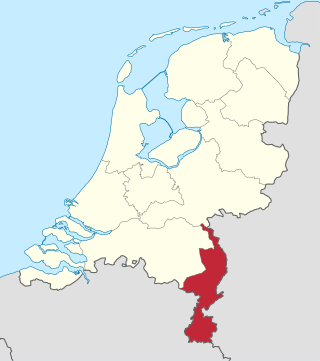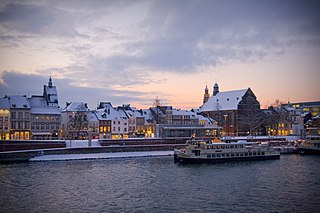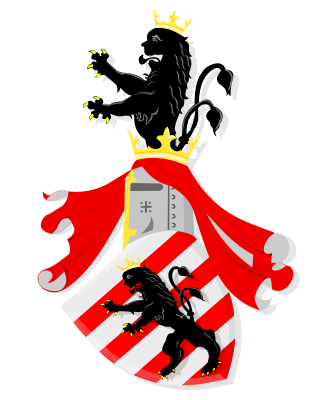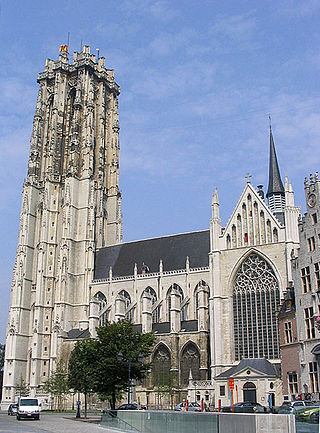Founder and inhabitants
The first lord of Hoensbroek was Sir Herman Hoen, who gave the castle its name (Herhoensbroeck). He was a member of the family Hoen van den / tzo Broeck, later changed to Hoen van Hoensbroek and Van Hoensbroeck. The name eventually passed to the later settlement of Hoensbroek (nowadays part of the municipality of Heerlen). Sir Herman Hoen's father, Claes, died in 1371 at the Battle of Baesweiler. Because of his support in the struggle against the Duchies of Jülich and Guelders, Herman Hoen was awarded the lordship Gebrook, Gebroek, Ingenbrouck (Broek being an old Dutch word for swamp, morass) in 1388 by duchess Joanna of Brabant, the lands in question being separated from the territory of Heerlen.
The castle was the ancestral home of the knights Hoen van den Broeck, the Imperial baron Hoen van Hoensbroeck, and the Imperial counts and viscounts Van en tot Hoensbroeck for nearly six centuries. The family Van Hoensbroeck left the castle at the end of the 18th century, after which the castle entered a period of decay. Count Frans Lothar sold the castle in 1927 to the present day owners, the foundation 'Ave Rex Christe'. It was thoroughly restored between 1930 and 1940. During and shortly after the second world war, the castle and accompanying buildings were used for diverse ends. In 1945, the castle was used for war orphans, under the Carmelite Sisters. From 1951 to 1973 the writer-poet Bertus Aafjes lived in parts of the castle. In the period 1986–1989 another restoration took place. Since then it has formed a popular and educative museum destination, funded by the municipality.
The complex
Over the centuries the castle has received extensive rebuilding and expansion three times. The different architectural styles from the different centuries (14th, 17th and 18th) are easy to separate from each other. The complex is surrounded by a moat and has four wings situated around a rectangular courtyard. The main building is reachable over a bridge. The main building has two identical square towers with union-tops, flanking the entrance, and two taller half-separate corner towers of irregular shape at the backside. The forecastles are both U-formed and enclose two large inner courts.
From 1720 to 1722, Frans Arnold, Imperial count van Hoensbroek, had substantial reworking done, including the building of a new north-western wing. The interior, with its illusionistic ceiling paintings from the 18th century, shows French influence. The son of Frans Arnold, Lotharius Frans, was the last lord of Hoensbroeck (1759–1794) who resided in the castle, until 1787, just before the French Revolution.

Limburg, also known as Dutch Limburg, is the southernmost of the twelve provinces of the Netherlands. It is bordered by Gelderland to the north and by North Brabant to its west. Its long eastern boundary forms the international border with the state of North Rhine-Westphalia in Germany. To the west is the international border with the similarly named Belgian province of Limburg, part of which is delineated by the river Meuse. To the south, Limburg is bordered by the Belgian province of Liège. The Vaalserberg is on the extreme southeastern point, marking the tripoint of the Netherlands, Germany and Belgium.

Maastricht is a city and a municipality in the southeastern Netherlands. It is the capital and largest city of the province of Limburg. Maastricht is located on both sides of the Meuse, at the point where the river is joined by the Jeker. Mount Saint Peter (Sint-Pietersberg) is largely situated within the city's municipal borders. Maastricht is adjacent to the border with Belgium and is part of the Meuse-Rhine Euroregion, an international metropolis with a population of about 3.9 million, which includes the nearby German and Belgian cities of Aachen, Liège, and Hasselt.

The Duchy of Guelders is a historical duchy, previously county, of the Holy Roman Empire, located in the Low Countries.

Limburg, also known as Belgian Limburg, is a province in Belgium. It is the easternmost of the five Dutch-speaking provinces that together form the Region of Flanders, which is one of the three main political and cultural sub-divisions of modern-day Belgium. As of January 2024, Limburg had a population of 0.9 million.

The Seventeen Provinces were the Imperial states of the Habsburg Netherlands in the 16th century. They roughly covered the Low Countries, i.e., what is now the Netherlands, Belgium, Luxembourg, and most of the French departments of Nord and Pas-de-Calais (Artois). Also within this area were semi-independent fiefdoms, mainly ecclesiastical ones, such as Liège, Cambrai and Stavelot-Malmedy.

Heerlen is a city and a municipality in the southeast of the Netherlands. It is the third largest settlement proper in the province of Limburg. Measured as municipality, it is the fourth municipality in the province of Limburg.

Heusden is a municipality and a city in the south of the Netherlands. It is located between the towns of Waalwijk and 's-Hertogenbosch. The municipality of Heusden, including Herpt, Heesbeen, Hedikhuizen, Doeveren, and Oudheusden, merged with Drunen and Vlijmen in 1997, giving the municipality its current form.

Eupen is the capital of German-speaking Community of Belgium and is a city and municipality in the Belgian province of Liège, 15 kilometres from the German border (Aachen), from the Dutch border (Maastricht) and from the "High Fens" nature reserve (Ardennes). The town is also the capital of the Euroregion Meuse-Rhine.

Landgrave was a rank of nobility used in the Holy Roman Empire, and its former territories. The German titles of Landgraf, Markgraf ("margrave"), and Pfalzgraf are of roughly equal rank, subordinate to Herzog ("duke"), and superior to the rank of a Graf ("count").

Hoensbroek is a Dutch town in the municipality of Heerlen. It is situated in the southeast of Limburg, a province in the southeast of the Netherlands. Until 1982, Hoensbroek was a separate municipality.

The Duchy of Limburg or Limbourg was an imperial estate of the Holy Roman Empire. Much of the area of the duchy is today located within Liège Province of Belgium, with a small portion in the municipality of Voeren, an exclave of the neighbouring Limburg Province. Its chief town was Limbourg-sur-Vesdre, in today's Liège Province.

The Duchy of Cleves was a state of the Holy Roman Empire which emerged from the medieval Hettergau. It was situated in the northern Rhineland on both sides of the Lower Rhine, around its capital Cleves and the towns of Wesel, Kalkar, Xanten, Emmerich, Rees and Duisburg bordering the lands of the Prince-Bishopric of Münster in the east and the Duchy of Brabant in the west. Its history is closely related to that of its southern neighbours: the Duchies of Jülich and Berg, as well as Guelders and the Westphalian county of Mark. The Duchy was archaically known as Cleveland in English.

The Duchy of Brabant, a state of the Holy Roman Empire, was established in 1183. It developed from the Landgraviate of Brabant of 1085–1183, and formed the heart of the historic Low Countries. The Duchy comprised part of the Burgundian Netherlands from 1430 and of the Habsburg Netherlands from 1482, until it was partitioned after the Dutch revolt of 1566–1648.

The House of Hoensbroeck is the name of an old aristocratic family with medieval origins in the town of Hoensbroek near Heerlen in Limburg, Netherlands. The family is part of Dutch and German nobility.

Upper Guelders or Spanish Guelders was one of the four quarters in the Imperial Duchy of Guelders. In the Dutch Revolt, it was the only quarter that did not secede from the Habsburg monarchy to become part of the Seven United Netherlands, but remained under Spanish rule during the Eighty Years' War.

Brabantine Gothic, occasionally called Brabantian Gothic, is a significant variant of Gothic architecture that is typical for the Low Countries. It surfaced in the first half of the 14th century at St. Rumbold's Cathedral in the city of Mechelen.

Eijsden Castle is a moated manor house with several farm buildings, a gatehouse and castle park, in Eijsden-Margraten, Limburg, Netherlands. The current castle was built in 1637 and is located next to the river Maas.

Hillenraad Castle is a 14th century square water castle located on the south side of Swalmen in the municipality of Roermond in the province of Limburg. The castle is located in the middle of an estate near the village of Boukoul. It consists of a moated main building with four corner towers, an outer castle, several outbuildings and a castle park. Hillenraad Castle has been a protected national monument since 1970. The entire complex consists of twenty separate entries in the national monument register, including the main building, the outbuildings and a number of elements in the park. The castle is not open to the public.

Tongelaar Castle is located between Mill and Gassel in North-Brabant, Netherlands.

Cuijk is a town in the northeastern part of the province of North Brabant, Netherlands. It is the successor of a Roman settlement on the west bank of the Meuse, 13 km (8.1 mi) south of Nijmegen. Cuijk, which had a population of 18,170 as of 2020, was the centre of an eponymous municipality, which ceased to exist on 1 January 2022, when it was replaced by the larger Land van Cuijk municipality.
























